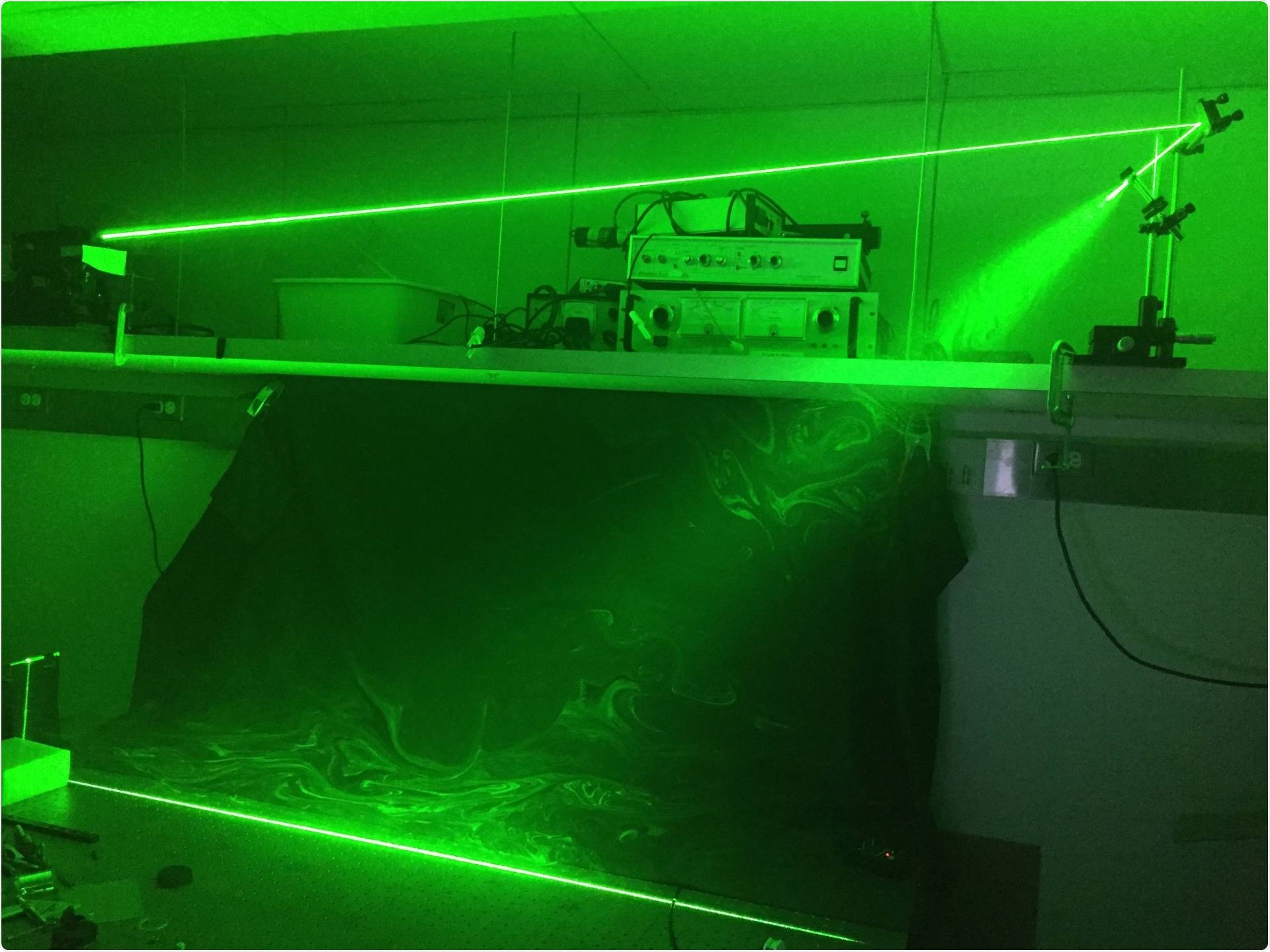The coronavirus disease (COVID-19), caused by the severe acute respiratory syndrome coronavirus 2 (SARS-CoV-2), primarily spreads through respiratory droplets expelled when a person coughs, sneezes, breathes or speaks.
A team of researchers and engineers at Princeton University has provided a visualization of how speaking produces and expels saliva droplets into the air. The smallest droplets can be inhaled by people, which is the primary mode of transmission of infections such as COVID-19.
A better understanding of how SARS-CoV-2 spreads should lead to new or better mitigation strategies and help slow down the pandemic, which has now claimed over 1.11 million lives worldwide and infected nearly 40 million people.

The researchers used this laser sheet to illuminate the saliva droplets. The laser light, originating at the left, is expanded to form a “sheet” going from left to right and about a meter high. The research subject (usually Manouk Abkarian of CNRS) would stand in front of the sheet or next to it, depending on the experiment. Drops from their speech or breath that crossed the sheet would produce flashes that they photographed and counted. Some experiments added a Halloween fog machine to see how the subject’s breath or speech droplets interact with the movement of ambient fog droplets. Photo by Manouk Abkaria
The study
The study, published in the journal Physical Review Fluids, highlights how the virus spreads through these respiratory as speech is a potent route for viral transmission of COVID-19.
The team aimed to show with high-speed imaging how phonation of common stop consonants, which are found in most of the world's spoken languages, form and extend salivary fragments in a few milliseconds as moist lips open.
When the mouth opens to produce speech sounds, a film of lubricating saliva spreads across the lips. When a person opens his mouth to speak, the film breaks into filaments. The lungs' airflow and outward from the mouth stretch the filaments until they break and scatter into the air as tiny droplets. All these happens within fractions of a second.
The research team visualized the formation of the droplets when speaking. The camera was zoomed in on the speaker's mouth and recorded a video at an extremely detail-revealing 5,000 frames per second under intense illumination. The footage was recorded at the millisecond level, frame-by-frame perspective, and showed the formation of a lubricating salivary layer on the lips as the speaker pronounced consonants.
“Both saliva viscoelasticity and airflow associated with the plosion of stop consonants are essential for stabilizing and subsequently forming centimeter-scale thin filaments, tens of microns in diameter, that break into speech droplets,” the researchers wrote in the paper.
Stop consonants
The researchers also found that the mechanism that produces these droplets are more pronounced when people use stop-consonants, including "p" and "b."
When people use these "plosives," the lips firmly press together to produce the sound. Hence, there is more power and force for the droplets to disperse into the air. Other consonants that produce droplets at a much greater rate are "t" and "d."
“We have made the first direct visualization of the mechanism that produces droplets in the oral cavity during everyday speech. Our study provides insights into the origin of droplets when people talk, which can aid in curbing the spread of diseases like COVID-19,” Howard Stone, the Donald R. Dixon ’69 and Elizabeth W. Dixon Professor of Mechanical and Aerospace Engineering, said.
COVID-19 transmission
Early in the pandemic, little was known about how the virus spread. Since it was a relative of other infections in the past, such as the severe acute respiratory syndrome (SARS) in 2002 and the Middle East respiratory syndrome (MERS) in 2012, many scientists believed that the main transmission route was through respiratory droplets.
Recent updates from the World Health Organization (WHO) and the U.S. Centers for Disease Control and Prevention (CDC) have acknowledged that the pathogen can spread through tiny aerosols, which hang and travel through the air. These aerosols can be produced even when a person speaks, breathes, and sings.
In the current study, the researchers wanted to bring their expertise in fluid mechanics to provide an insight into how COVID-19 spreads, explaining why the virus has spread at a fast rate across nations.
They focused on asymptomatic transmission, which is described as the virus's spread from people who were not coughing and sneezing. It turns out. The virus can also spread when people speak.
The study's findings strengthen the importance of wearing masks and practicing social distancing, especially in public places. The researchers also believe that wearing masks should effectively contain a significant number of expelled aerosols. Further, they said that the simple way of wearing lip balm should cut down on droplet formation when talking.
Sources:
Journal reference: